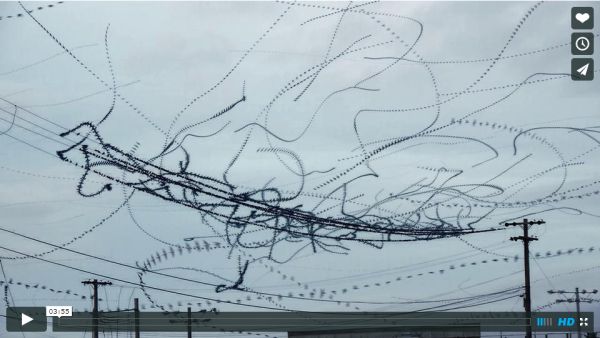If birds left a visual trail in the sky, what would their flight paths look like?
Dennis Hlynsky, an artist and professor at the Rhode Island School of Design, has been experimenting with this for several years. He became interested in birds when “During the winter of 2008 I left the house in the wee early morning looking for anything to record with my new pocket video camera. I began to notice life above.” Since then he’s been filming birds and animals, then using Adobe After Effects to convert their motion to dotted trails. Fast-moving birds become open dashes, slow-moving ones are thick lines.
Starling videos are especially interesting because the flocks collect a few birds at a time and flee in a tightly packed blob. Click on the screenshot above to watch Hlynsky’s video “data in data out” of starlings on wires in East Providence.
Thanks to Traci Darin for pointing out this video in an article on the Colossal website where you can see an animation and three additional flight path videos. Or click here for Dennis Hlynsky’s “small brains on mass” website where he’s posted videos of birds, water striders and the carp feeding at Linesville, PA.
(screenshot from Dennis Hlynsky’s video “data in data out” on Vimeo)

Hi Kat, I have a question:nearly every night in fall and winter huge, slow moving flocks of crows fly by our house in Edgewood. A friend and are having a debate about what they are doing; She thinks they are migrating, I think they gather in large social groups in winter evenings to roost together and then seperate at dawn. Which is correct? Thanks
Patrick, the crows are visiting Pittsburgh for the winter, a phenomenon that has gone on for many years. They roost overnight in the city, huddling together to stay warm, because the city is warmer than the countryside. During the Pittsburgh Christmas Bird Count on December 28 we counted 32,700 crows at the roost. On Dec 28 the roost was in the Hill district but the crows move it around. This weekend it’s near the Strip District.
During the day crows disperse from the roost up to 30 miles to find food. Often they go to the dumps at Imperial or Wilmerding because there’s a lot of food there. Then at dusk they all fly back to the roost. That’s what you see over Edgewood. The crows going “home” for the night.
Beginning in late Feb/early March the number of crows will fall as they leave for their breeding territories in the suburbs & north.
Here’s a selection of links to blogs about Pittsburgh’s winter crows:
How Crows Stay Warm
The crows move the roost.
The crows adapt to a changing landscape.
October 23, 2013: the crows are back in town.
And a video taken from the Strip District last January